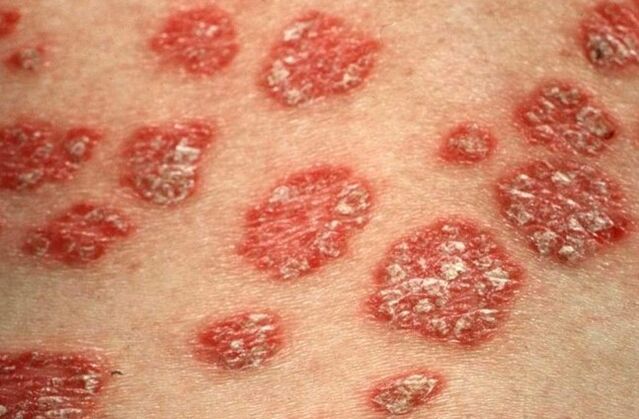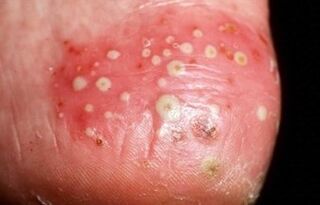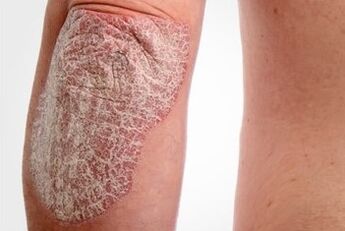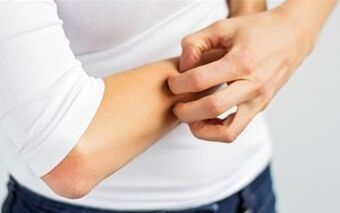The sooner a person recognizes psoriasis and begins his treatment faster, the higher the likelihood that the pathology will not flow into a difficult stage.And in order to be confident in the definition of this type of dermatosis, you need to have an idea of the initial stage of the disease.It is not particularly difficult to understand this, because psoriasis has characteristic characteristic features only to it.

How does psoriasis manifest at the initial stage?
The disease proceeds in exciting.One stage replaces the other.Psoriasis has three stages:
- progressive or initial;
- stationary;
- Retrogressive.
Symptoms of each period differ depending on the type of psoriasis.
Early symptoms in adults
A lot of factors are capable of giving impetus to the development of skin pathology.It can be genetics, infection, cuts, problems with internal organs.But sometimes it’s enough just to be nervous, and the skin will immediately “respond” to the stress with a psoriatic rash.
In the beginning a small bundle appears (papule).It has a reddish color and clear boundaries.Soon similar rashes join him.Papules merge with neighboring plaques and grow more and more.They itch hard, inflamed and painful.
In order not to confuse papular rashes with ordinary skin irritation, you need to know the signs of psoriatic triad:
- In the beginning - Stearic spot.This effect has a characteristic feature: if you accidentally damage Papule, then peeling will increase.Even if before that there were no visible epithelial scales on the plaque, as soon as you start combing them, they will appear.The plates are separated painlessly.They are dry, have a silver color and resemble wiped paraffin drops.The reason for this symptom: violation of intercellular contacts;
- Thermal film.When all the scales from the plaque are removed, a brilliant reddish surface is exposed.Reason: acanthosis;
- Blood dew.If you scrape the papule further, small droplets of blood that do not merge with each other will begin to appear on its surface.Reason: damage to the capillaries of the dermis.

Early symptoms have differences depending on the type of psoriasis:
- pustular.It is characterized by rashes in the form of bubbles filled with transparent liquid.The body temperature, although not significantly, is increasing, a person experiences weakness.If you comb the bubbles, there is a high probability of infection in them, which is fraught with suppuration and inflammation;
- vulgar.It is recognized by reddish thickened formations (Papule) with Scaly with a white raid.With a small area of damage (3% of the skin), the rash can pass on its own;
- Hollow -shaped.In this case, the plaques outwardly resemble droplets, they are so small.The color of the papules is intensively red.At the initial stage, their number is small, but if you are late with treatment, the rash covers the whole body;
- Psoriatic arthritis.Its peculiarity is that against the background of dermatosis there is a damage to the joints.They become inflamed, hurt and poorly bend;
- Psoriasis of nails.The initial stage is characterized by a change in the nail plate.Groundings and small pits appear on it.Gradually, the nail thickens.
This is observed in children wearing diapers.Therefore, psoriasis at this stage can be confused with allergies or Libero dermatitis.The difference lies in a clear border between the area of defeat and healthy skin.
What does psoriasis look like at the initial stage?
In addition to the psoriatic triad, there are several more symptoms confirming psoriasis:
- Köbner phenomenon.Characteristic of the initial stage.If you damage (scratch or cut) healthy skin, then after 2 weeks new papules will be formed at this place;
- Pilnova rim.In this case, psoriatic plaques have a red border, as if repeating the contours of the lesion.This symptom indicates the progression of pathology;
- Papules are formed symmetrically.They are raised over a healthy surface.

Characteristic places of location: bends of the arms and legs, nail phalanxes, the outer side of the knees, elbows, a hairy zone of the head, stomach.Close clothing can also provoke a rash.In places where it constantly rubs the skin (straps, a belt of trousers, narrow linen), psoriasis will develop in the first place.
The initial stage lasts several weeks.But its duration can be reduced using competent treatment tactics.
The rash on the skin will be very itchy.If you take into account all the symptoms and suspect psoriasis at yourself, do not delay the visit to the dermatologist.
It is difficult to make a diagnosis independently, since this type of pathology is multifaceted in its manifestations and has several varieties.And for each case there is a special treatment.
Hair falls on the back of the head - a sign of the disease or not?
Indeed, the scalp (hairy zone) with psoriasis often suffers.
To stop the spread of the lesion, it is important to know its symptoms:
- Initially, there is a weak peeling of the skin in the affected areas.More often on the back of the head;
- Gradually peeling covers other areas of the scalp.There is slight itching and irritation;
- Then the itching becomes stronger.The patient begins to comb sore spots.As a result, bleeding wounds and cracks appear on the skin;
- At the next stage, the situation worsens: plaques increase in size, the skin is coarse.

Further, the active process of exfoliation begins on Papule.Gray scales appear.In the absence of treatment, the lesion will go beyond the hair zone: on the neck, back of the ears, forehead.
Psoriasis is rarely the main cause of hair loss, since the lesion occurs only in the upper layers of the dermis.Hair bulbs usually do not suffer, since they are located deeper.And only the advanced form of the disease can damage the base of the hair.
It is important to recognize the disease at the initial stage.It is difficult to do it yourself, because a person takes a psoriatic rash for simple irritation, and scales - for dandruff.
Therefore, if you suspect psoriasis of the head, you should immediately contact a dermatologist.Do not practice self -medication, since this dermatosis is similar in symptoms with Seborrheal dermatitis, and only a doctor will make an accurate diagnosis.
Does the body itch at the beginning of the development of the disease?
Itching can be called the first sign of the disease.It is always observed at the beginning of the pathology.This is because psoriasis provokes a failure in the operation of the immune system.
And an abnormally rapid cell growth is launched, forming plaques on the surface of the skin.At the early stage of pathology, the body reacts to these changes in the form of itching, which can be unbearable or weak and not particularly annoying.It is possible to remove itching with special ointments, and sometimes it is enough to change the diet.
What diagnostic methods help to recognize the disease?
It is enough for an experienced doctor to diagnose psoriasis to examine the patient's skin.Symptoms typical of the disease allows you to quickly determine the type of pathology and prescribe appropriate therapy.
However, there are complex cases requiring additional information.The obligatory study in this case will be a biopsy of the sample of affected skin.It will allow you to accurately determine the pathology.
A test with potassium oxide is also carried out (if the fungus is suspected).When dermatosis affects the joints and causes arthritis, you should contact a profile specialist.

He will prescribe radiography and the necessary tests.UV radiation will help to clarify the diagnosis.With the lumen of the Excimer papules with a laser, a glow of peeling areas will be seen.
Since psoriasis in symptoms has similarities with other dermatoses, differential diagnosis is necessary.
Differential diagnosis will exclude pathologies such as:
- red lichen;
- Reuters' disease;
- seborrheic dermatitis;
- Neurodermatitis and others.
The listed studies will allow the dermatologist to prescribe the most effective therapy to the patient.
Is it possible to cure a beginning disease?
Alas, psoriasis is an incurable disease.But the correct and in time therapy can return the skin a healthy look and extend the time of remission.It is very important to exclude provoking factors, avoid stress, eat right, less nervous and observe hygiene.
How to be treated with the initial form of the disease?
At the initial stage, psoriasis should be treated comprehensively.Today, quite highly effective drugs that, although they will not give a complete recovery, will eliminate the peeling formations that do so spoil the patient's life.
The modern tactics of treatment have undergone changes in the favor of non -hormonal drugs (gels, solutions, emulsions) and aromatic Retinol.
Popular ointments for psoriasis:
- based on tar;
- based on Solidol;
- from oil;
- Softening tools.
Non -traditional treatment methods
Here are some folk remedies effective at the initial stage of pathology:
- linseed oil.Apply locally to the affected areas;
- Solidol.They are lubricated by sick areas once a day before bedtime;
- Celandine juice.It is effective in the easy form of psoriasis.

Traditional medicine knows many completely safe recipes for skin regeneration, but, using them, one should remember some difficulties:
- The preparation of the product takes a lot of time (several days).It is very important to clearly follow the proportions.The slightest negligence will negate all efforts;
- controversial efficiency.Since folk remedies did not undergo clinical trials, it is not worth expecting a complete cure from them;
- intolerance to components.When a homemade medicine is ready, testing: treat them with a small area.If itching or redness appears, then the tool is not suitable for you.

















